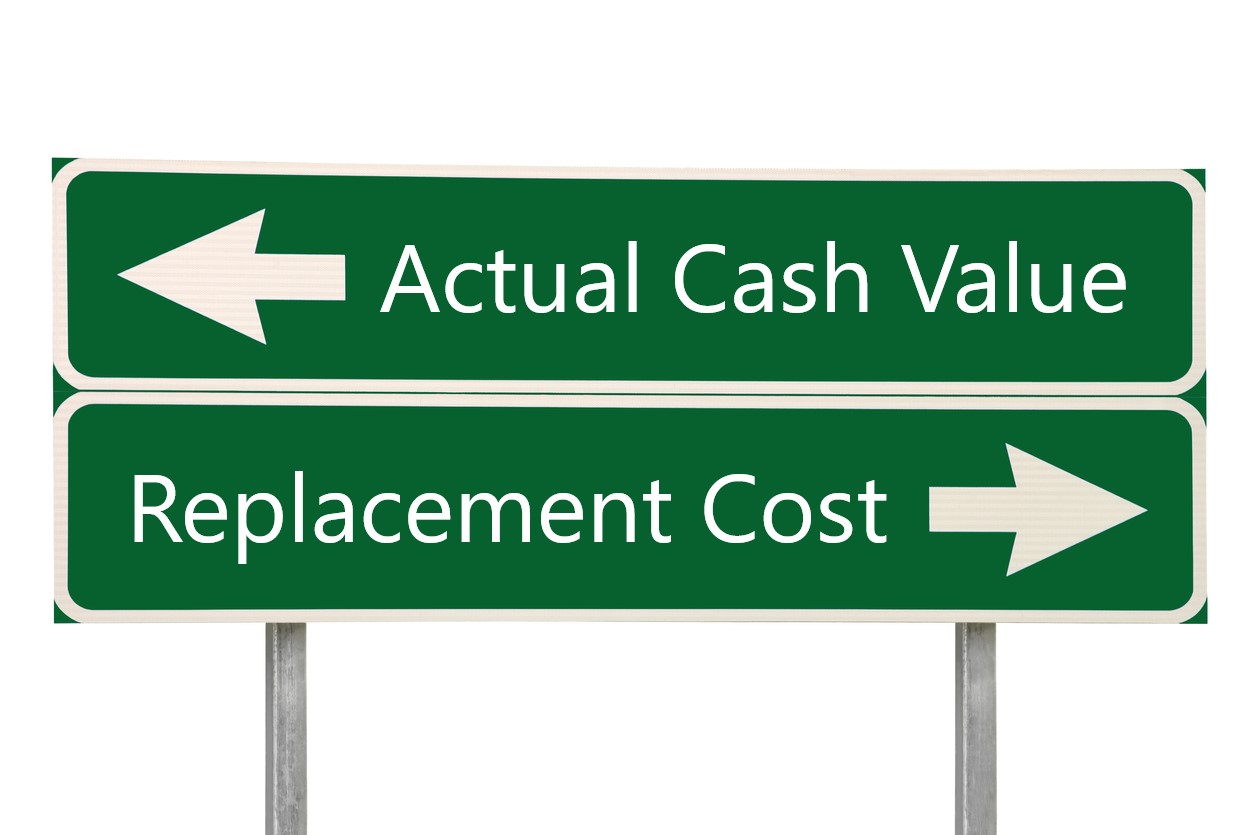Actual Cash Value Proof Is Important Under Most Replacement Cost Policy Disputes

Replacement costs policies are supposed to pay replacement cost benefits, right? The truth is that only a few very high-end replacement cost policies pay replacement cost benefits immediately following a loss. I suggest that you call Chubb and Amica if that is the type of policy you want or ask your agent to provide a replacement cost endorsement that pays for immediate replacement.
Most replacement cost policies are a misnomer because they only pay replacement cost benefits when a repair or replacement is made. Most replacement cost policies pay the actual cash value until replacement is made. I honestly think most of the insurance industry should be prevented from selling their products as “replacement cost” products because they are not when compared to true replacement cost policies. If the insurance selling industry is honest, what most are selling is contingent replacement cost coverage.
A recent appellate decision1 points to the importance of having not only a replacement cost estimate but an actual cash value estimate backed up with proof of causation if the insurance company questions that the damage is covered under the policy. Policy language is important and the first place to start in the coverage. The court noted:
The policy stated that Ohio Security had the ‘option . . . [to] either’ ‘[p]ay the value of’ or ‘the cost of repairing or replacing the lost or damaged property’ ‘[a]t [its] actual cash value as of the time of loss or damage.’ If Metal Products ‘elect[ed] to have loss or damage settled on an actual cash value basis, [it could] still make a claim for’ replacement cost. Metal Products had to give ‘noti[ce] . . . of [its] intent to do so within 180 days after the loss or damage and then ‘[r]eplacement Cost (without deduction for depreciation) replace[d] Actual Cash Value [as] the [type of] Valuation . . . .’ But ‘no[] pay[ment] . . . [of the] replacement cost basis’ occurred ‘[u]nless the repairs or replacement [were] made as soon as reasonably possible after the loss or damage’ and ‘[u]ntil the lost or dam-aged property [was] actually repaired or replaced.’
The appellate court then noted the claim and estimate provided by the policyholder:
Metal Products timely filed a claim for coverage for damage to its two buildings from Hurricane Michael. The company submitted an estimate from RestoreMasters Contracting LLC that calculated a total ‘Replacement Cost Value’ of $818,745.12. The estimate described repairs needed for the roofs of both buildings and for the interior of building caused by water intrusion. The estimate quoted identical replacement costs and actual costs for the repairs and contained no deduction for depreciation.
The disputed issues between the parties were then noted as follows:
Metal Products complained that Ohio Security breached its contract by ‘refus[ing] to reimburse . . . adequately for damages’ from a ‘hurricane event.’ Ohio Security answered that Metal Products was not entitled to replacement cost damages because it had made no repairs to its property and that the interior damages to building were excluded from coverage as caused by wear and tear and deterioration. During discovery, Metal Products demanded ‘$740,820.47 in indemnity’ based on the RestoreMasters estimate, which it admitted did not account for depreciation. Metal Products also admitted it had made no repairs to its buildings.
The court found that the insurer did not breach the contract:
Ohio Security did not breach its contract with Metal Products. Metal Products submitted an estimate that calculated the replacement cost damages to its buildings. The insurance policy states that no payment is made on a claim for replacement cost value ‘[u]ntil the lost or damaged property is actually repaired or replaced.’ So ‘[u]nder the terms of the policy, [Metal Products had to] actually repair or replace the damage as a condition precedent to payment of replacement costs.’ Fla. Ins. Guar. Ass’n v. Somerset Homeowners Ass’n, Inc., 83 So. 3d 850, 852 (Fla. Dist. Ct. App. 2011). Because Metal Products made no repairs, Ohio Security was not obligated to pay the replacement cost value of the buildings.
… Metal Products submitted only an estimate from RestoreMasters to support its claim for coverage. And that estimate calculated only replacement cost damages. Metal Products could not change the nature of its demand for payment by asserting, in its opposition to summary judgment, that its estimate “contain[ed] both ACV and RCV values.
When discussing this case in our firm, we noted that the policyholder did not retain a causation expert to refute an insurance company’s expert about causation. Since the insurance company had causation evidence supporting that it had paid for the actual cash value of all parts of covered damage, and the policyholder did not rebut that opinion, the other lesson is to have rebuttal causation evidence.
There are other important issues about this case that should be discussed. The biggest questions relate to where the money is to come from to pay for replacement costs when an insurer wrongly denies or underpays the actual cash value amounts owed. Still, the lesson is to make replacement cost estimates with valid actual cash value estimates.
Thought For The Day
The greatness of America lies not in being more enlightened than any other nation, but rather in her ability to repair her faults.
—Alexis de Tocqueville
____________________________________
1 Metal Products Co., LLC v. Ohio Security Ins. Co., No 21-11612 (11th Cir. Jan. 12, 2022).



